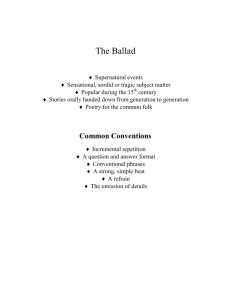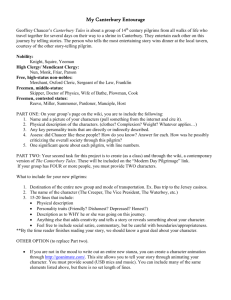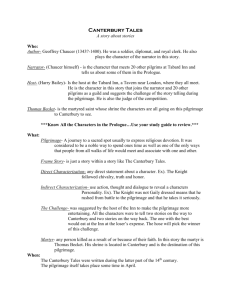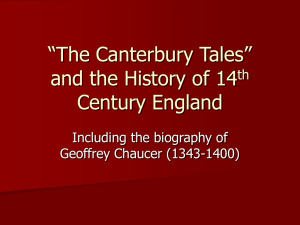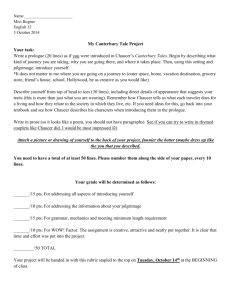Chaucer's Canterbury Tales (Pilgrims Powerpoint)
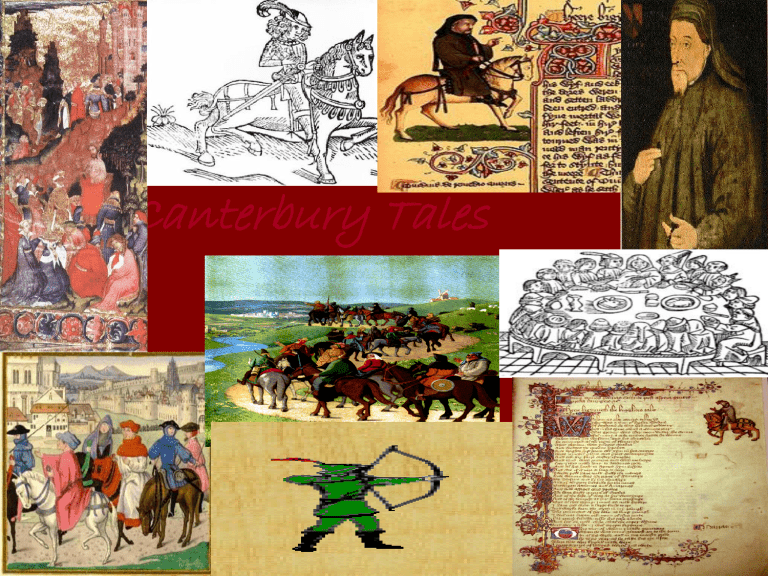
The Canterbury Tales
Geoffrey Chaucer
*Chaucer himself is depicted in the Canterbury Tales as the narrator; he is initially perceived as gregarious and naïve, and later described as silent. His opinions of each character flagrantly show through in the manner in which he writes each tale
Geoffrey Chaucer (c. 1343 – 25 October 1400)
*Chaucer’s various experiences throughout his life helped to pave the way for the writing of The Canterbury Tale
*began writing as a poet in his twenties, his earliest works being translations of other
European poets
*The Canterbury Tales, arguably his most famous work, was believed to be written as an inspiration from his pilgrimage to Canterbury, as he was able to observe a diverse group of people, including
* Only 24 out of 120 stories were told, all composed of various genres of medieval literature
* deemed “The Father of English Poetry” as he was recognized as the greatest English poet of his time
* His cause of death is not quite known, as his tomb was built over one-hundred years following his death and there is little historical record to affirm any distinct cause
Geoffrey Chaucer
Chaucer was included in the social class of the merchants, along with his parents. They consisted of the middle class.
Chaucer was a modest, inquisitive, and gregarious character. He was very intelligent and his gift for writing is evident in his vast variety of works.
He is depicted as wearing a dark coverchief on his head, which is similar to a Val that nuns wear. He is also shown dressed in a long, black cloak.
He is revealed as having a serious and grave expression along with a fully developed beard. His hair cannot be explained because he is always shown wearing his coverchief.
The Pilgrimage from Southwark to
Canterbury
59.4 miles away.
It would have taken at least 4 days to travel this distance back for most people, but Chaucer has his pilgrims do it in 1 day.
They left Southwark in the morning and arrived in Canterbury as the sun was setting.
They rode horses on this pilgrimage.
For Medieval men a pilgrimage was a symbolic journey that represented the course of human life, from one's home on earth to one's true home.
The Tabard Inn
The Tabard was an inn established in 1307 by abbot of Hyde, the head of a Benedictine Monastery just outside of England.
It was established to provide a hostile for him when he traveled to England and to accommodate all of the pilgrims heading to England.
These pilgrims traveled to England to see the Shrine of Thomas Beckett in Canterbury Cathedral.
The Tabard was located on the East Side of Borough
High street in Southwark, an area on the east- side of
London.
Canterbury Cathedral
Location
Canterbury Cathedral is located in
Canterbury, Kent.
Appearance
One of the oldest and most famous Christian structures in
England.
Thomas Becket Archbishop of
Canterbury
· After his death, this became a major pilgrimage destination.
Thomas Becket had a falling out with King Henry II, and this led to his murder in the Canterbury
Cathedral.
Canterbury Cathedral
Canterbury, Kent
Country: United Kingdom of Great Britain
Founded in 602AD by St. Augustine
One of the oldest and most famous Christian structures
It was probably an existing church building from Roman times
The cathedral was set on fire in 1011 by marauding Danes
In 1067 another fire broke out, destroying what was left of the Saxon cathedral
In 1070 Archbishop Lanfranc began to rebuild the cathedral
After Lanfranc, Anslem added the towers abutting the eastern transepts and the crypt, largest of its time in England
Thomas Becket was archbishop in 1162 to death in 1170
On December 29, 1170 Thomas Becket was murdered in the cathedral by 4 knights because he refused to pardon men he had excommunicated
Still functions as the cathedral for the archbishop of Canterbury
What is a pilgrimage?
A pilgrimage is a journey of a pilgrim, especially one to a shrine or a sacred place
During the Medieval times, people would make extensive journey to visit the resting place of saints or to visit sacred relics
Jerusalem and Rome were popular pilgrimage sites during the Medieval period
Many people decided to journey in groups as it was safer to travel in numbers
These journeys would take months, and numerous times, the pilgrims may not return because it was dangerous to travel to an unknown destination
There were several spots along popular pilgrim routes that were hospitable to the travelers
At these resting stops, the pilgrims would eat, rest, drink, and tell stories of their journeys and of the sites they been to
Because faith was very important to the people of the Medieval times, many travelers believed that visiting the site would absolve them of their sins
The Knight
Distinguished man
Followed chivalry, truth, honor, generousness, and courtesy
Honored for his noble graces
Successful fighter
Aristocrats or military class served with distinction in many campaigns wise, modest and polite very worthy man not gaily dressed wore a fustian tunic stained and dark with smudges where his armor left a mark not vain takes the pilgrimage seriously enough to rush to join straight from battle possessed fine horses
The Squire
Appearance
Strong and agile
20 years old
Curly hair
Average height
Social Class
Aristocrat or Military
Additional Information
Son of the Knight
Brave
Cavalryman
Good rider
Veteran of combat
Devoted to his father
The Yeoman
The Yeoman was an archer and worked for a knight or squire. He wore a green hood and coat. His head was like a nut and his face was brown.
He carried arrows with peacock feathers. He knew woodcraft. Yeoman wore a brace on their arm and bore a shield and sword. The yeoman also held a hunting horn. They were proper foresters.
The yeoman was considered a noble, but was the lowest of the noble class. He could be a free man and own a small estate. Yeomen became a class of people that gained a reputation for hard toil.
The Prioress (The Nun)
Appearance
· Has a simple, shy smile
· Grey eyes
· Very clean
· Wears a nice cloak
· Has a coral bracelet and a golden brooch
Social Class
· The clergy as a nun
Other Information
· Has very good table manners
· Very kindhearted, charitable, and respectable
· Real name is Madam Eglantyne
· Speaks French
· Anti-Semitic
THE MONK
Appearance
Rugged
Manly Man
In good shape
Bald and has a shiny head and face
Wears very different robes of the usual monks which was a plain habit and hood but wore gray fur on his sleeves of his cope and a gold pin with a love knot at the end of the hood
The gold pin signified that he was not religious because instead of the gold pin it should be a rosary.
Social Class
Clergy
Abbot meaning father, religious title given to the head of the monastery
Information
Rebellious
Ignores rules and lives and controls his own life very unlike monks of the time
Hunts and rides horses instead of studying, praying, and working which the rules of the monastery forbids
He is believed to have joined the monastery because he wanted be separated from betrayal of people and of women.
Friar
Social Class: clergy
Jolly, Festive
Pale-skinned
Strong
Happy and sturdy voice
Good singer and hurdy-gurdy
Sparkly eyes
His name was Hubert.
Courteous
His job didn’t make him wealthy but he knew how to make a profit
He wasn’t like the friar’s before him
Limiter
Most Mellow of the Four
Orders
Match maker to many girls
Got many girls in trouble
Was able to hear confessions
Forgiving to all people
Made a decent living
Knew taverns and inns best
Easily got money from people
Deceiving, Immoral
Made a profit off of all that he did for people.
Wore a robe
The Merchant
Appearance
· Forking beard
· Motley Dress
· Beaver hat
· Buckled boots
· Sat high on his horse
Social Class
· Free, High status non-noble
Info important to lifestyle
· An expert at currency exchange
The Oxford Cleric
“The Student”
A. appearance:
1.
thin, had a hollow look and a sober stare
2.
worn out, thin clothes
B. social class:
1. middle class
2. peasant-born
C. personality:
1.
knowledgeable young student who would do anything to gain more knowledge
2.
3.
preferred books over money and nice things quiet and reserved
4.
never spoke more words than he needed to formal and respectful
Sergeant at the Law
Very wise
Talked little
Tricked people into thinking he was wiser and busier the he really was
A very good lawyer, could make a fool-proof contract or give a great defense
Knew the law by heart
Took large fees and lived well, middle class
Commissioned by the King of
England
Sergeant at the Law
He is discreet
He is a able attorney
Wary and wise
Makes people think he is bruiser and wiser that he really is
A very busy man
Wore a homely parti-colored coat with a pin-stripe silken belt
Important in his social class
The Franklin
Franklin means “free man”
White-bearded and redfaced
- Like Santa Claus
Wealthy gentleman farmer but was not born noble
Middle Class
Loves food
- House seemed to snow meat and drink
Enjoys good living
Well-liked by other pilgrims
The Franklin
•
A medieval wealthy land owner.
•
His beard was white as a daisy-petal.
•
Sanguine, high colored, and benign.
• He was a free man; He didn’t serve a lord but was not a noble.
•
He lived in pleasure believing that happiness is the most important goal in life.
•
He is a connoisseur of food and wine, so much so that his table remains laid and ready for food all day.
The Weaver
Wise, fit to be noble
Trim and fresh, silver knives had money
Clothe making profession
All artisans.
They are dressed in the livery, or uniform, of their guild.
The narrator compliments their shiny dress and mentions that each was fit to be a city official.
Demonstrate the pride associated with being a guild member successful people
Guilds are professional organizations for craftsmen
The characters are proud of their wealth and display it with ornate objects
The wives enjoyed the status of the husbands
Gave the women social recognition
Demonstrate the pride associated with being a guild member belonged to a guild
(associations of tradesmen, somewhat powerful in this time period) dressed luxuriously their wives are demanding and controlling, were social climbing
The Dyer
Dyers used many components from to make inks.
· They used colorful dyes and stains
· They could dye anything from furniture, drapes clothing or fabrics, to decorate materials and artwork
· Dying was not always for enjoyment
· Dying was a trade that often served the nobles
· Dying was not only tedious and needed a meticulous mind frame but It was also dangerous.
· They used plants that were dangerous and often poisonous if even handled or inhaled and especially ingested
The Carpenter
The tapestry-Maker
A haberdasher is a person who sells small articles for sewing, such as buttons, ribbons and zippers. In English, haberdasher is another term for a men's outfitter. A haberdasher would sell small accessories, like linens and silks.
Another meaning of "haberdasher" refers to a "dealer in, or maker of, hats and caps.”
Medieval craftsmen, like haberdashers, belonged to guilds. Each guild had a hall or house to meet in.
The members worked together to insure the quality of their work, train apprentices, set prices, care for the sick members of their guilds and the widows and children of deceased members. The men of the guild were wealthy, and their sons were automatically born into the guild.
The Cook
Name was Roger
Skillful
Master of his trade
Good at cooking
Cut on his shin
Best dish was Creamed Chicken Pie
Trade Class
Rude and vulgar man
Engages in violent and arguable behavior
The Skipper
Appearance
He wore a woolen gown that reached his knee
He had a dagger on a lanyard that hung from his neck under his arm and down
Tanned by the summer heat
Was an excellent fellow
Social Class
Trade class
Info important to lifestyle
Came from far west, he came from Dartmouth
The nicer rules of conscience he ignored
He was hardy, prudent in undertaking
The Doctor
Social Class
He was part of the Middle Class
Appearance
He wore blood red garments with bluish gray in them and they were lined with taffeta (which was used for formal wear).
Personality
He made most of his money from when plagues struck his country and he tended to rip people off. Gold and money was very important to him. He was somewhat greedy.
He was very intelligent in the field of medicine. He knew the cure for any malady that you had. He also was educated in astrology; he could read you your stars and tell you your luck. He knew his medical information by heart but did not know the Bible at all. He was not a very holy man.
As for food, he only ate what was nutritious and never ate food for pleasure
The Doctor
•
One of the best of his profession
Could heal almost any illness
Was in very good shape, thin
Has an obsession with gold and finical gain
Believes in study of stars.
The Wife of Bath
A deaf but intelligent woman
· A very skilled tailor, a person who creates clothes
· She wore very heavy kerchiefs
· Her shoes were soft and new
· Bold, beautiful face but a little reddish
· She had five husbands
· She was alone during her childhood
· Skilled in traveling
· She had spaces in her teeth
· She had large hips that was covered by a mantle
· Likes to laugh and talk to others
· She knew how to flirt very well
· She was the type that couldn’t keep her man down. She was too outgoing.
The Wife of Bath
· A bold, handsome woman, deaf in one ear and gap toothed
· As a seamstress, she is dressed rather extravagantly in scarlet colored clothes
· She is a worldly woman, having seen many different places
· After living with five different husbands, she is experienced and well versed in the games of love.
· Through her experiences, she has gained intellect, independence, and the ability to provide for herself
THE PARSON
Wore a tabard, loose jacket.
Poor in his social class, rich in holiness and work.
Stands out as what the parish priest should be.
Lived a perfect life taught others to follow.
Ideal Christian Priest.
Social Class- the Clergy
Truly knew the gospel and preached it
Disliked extorting the tithe
Gave to the poor out of his own belongings
Nothing stopped him from preaching
A description of physical appearance is not given because a parson is a stereotype of the perfect priest.
The Miller
The Miller was a broad, well-muscled man who could easily wrestle a ram.
The Miller’s job was to grind wheat into flour using large rocks which constituted his large musculature.
The Miller was so adept at his trade that he could tell the quality of grain simply by feeling it.
The Miller’s social standing was with the lot of the
Peasants. However, because of his wealth, not as much as a noble’s, he was held with higher regard among the peasants.
Manciple
Appearance
Elderly Gentleman
Bearded
Wears a long cloak and hat
Social class
Trader
Steward for a law school in
London
authorized to buy provisions (food or other necessities)
Relevant Information
Never rash
Illiterate
Wiser than thirty lawyers he feeds
Cunning
Cheated well-educated lawyers
by putting aside a tidy little sum for himself
Came from Inner Temple
All carters follow his example in buying
Used to watch the market carefully
Go in first do he did well in shopping
Reeve
Reeve was a slender man
He had a beard shaven to the best of his ability; it was as clean-shaven as he could get it to be
His hair looked as if it were cut by clippers; cut around the ears long legs and was very lean short temper could be angered very easily belonged to the middle class.
Good writer carpenter
An administrative officer (high rank)
The Summoner
Appearance:
The Summoner had a fire-red face, with boils all over.
He had pimples all over his face, and nothing could get rid of them.
He wore garland around his head
His breath was wretched because he loved to eat garlic and onions.
Social Class:
He was in the lower class.
His job was to the send those who were arrested for sins to court.
Lifestyle:
He was a drunken man, and slurred too often, only in Latin.
He rarely followed any of the law.
He was a scary man and partook in too many sexual activities.
He believes he is more knowledgeable than most people.
Plowman
Appearance
Wore a tabard(loose jacket) smock
He would not have been dressed up in nice clothes because of his occupation and he might have smelled from carrying manure
Occupation
He worked in fields
He dug corn and carried manure
Social Class
The Plowman’s social class is considered to be among the virtuous poor or lower class
He was extremely poor but represented all the Christian values and virtues
Relevant information to the lifestyle of the pilgrim
He was a good worker who was religious
He lived in peace and charity and treated his neighbor with much respect
Plowman helped the poor and was always charitable
He was the Parson’s brother
He always paid his tithes and they were on time and in full
Pardoner
Appearance
Long, blonde hair
Wears a cap with a holy relic on it
Big, bulging eyes
Smooth facial skin
Social Class
Clergy, Freeman, contested status
Lifestyle Information
A pardoner is one who dispenses papal pardons.
He was gentle and patient because of working with the pope.
The Host: Harry Barley
Appearance
Bright eyes
Wide body
Manly
Very handsome
Social Class
Trader class
Information
Joyful man
Kind-hearted
Generous in giving food and drink
Invented the idea of telling the stories of the pilgrimage
Offers dinner to the pilgrim who tells the best story
Maintains peace
Guides the trip


